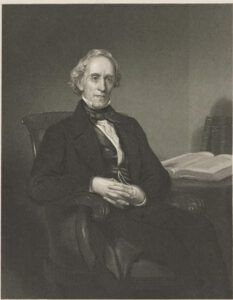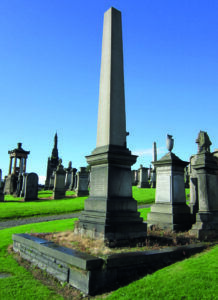Robert Kettle
by Colin Campbell and Morag T Fyfe
Robert Kettle was born in the village of Kintillo, parish of Dunbarney near Bridge of Earn, Perthshire on 18 December 1791. There seem to have been more than one family of Kettles in the parish at the time but it has proved impossible to identify his parents. He must have had a sister as two nieces surnamed Geddes were living with him in Glasgow from at least 1841.
He seems to have been a studious and pious boy who would have liked to study for the ministry had his parents been able to support him financially. Instead he was apprenticed to a weaver. At the end of his apprenticeship he became a clerk in a firm in Perth for five or six years before moving to Glasgow in 1815 where he joined the firm of William Kelly and Co, cotton trader. In his early days in Glasgow he rented a room in Balmanno Street for 2s 6d per week. He paid 5s for a ticket which allowed him to attend lectures at the Andersonian Institution for three months and was impressed by Dr Ure’s lecture, with demonstration, on coal gas.
Soon after settling in Glasgow Robert came under the influence of Dr Thomas Chalmers of the Tron Church. At first he had to stand on the stairs or in a passage way to hear Chalmers preach as the church was so crowded. Through his attendance at the Tron, he became a deacon, and set up a Sunday School. He became a close friend of Thomas Chalmers and also of the Rev Edward Irving, Chalmers’ assistant and missionary in St John’s parish. In 1832 Robert left the established Church of Scotland and in 1834 he joined a Baptist congregation.
In 1829, he encountered some financial difficulties when William Kelly and Co. went bankrupt but he overcame them to set up his own business as a cotton yarn merchant and eventually became very successful.
That same year a group of gentlemen including William Collins, the bookseller, were attempting to establish a temperance society. Robert Kettle did not join immediately but after an accident on a steamboat due, he was sure, to him having drunk too much toddy, he changed his mind. By July 1830 he was about to commit to the temperance movement and in December 1831 he became one of the treasurers of the Scottish Temperance Society; the following year he became secretary, a position he held until 1836.
The earliest temperance societies tended to focus on abstinence from distilled spirits which left the door for consumption of wine and certain other alcoholic beverages. In 1832 the first attempts were made to form total abstinence societies. In 1836 the Glasgow Total Abstinence Society was formed open to men and women alike. The third rule contained the following pledge: “I voluntarily promise to abstain altogether from Ale, Porter, Cyder, Wine, Ardent Spirits, and all other intoxicating liquors, (except as a Medicine, or in a Religious Ordinance); that I will neither give nor offer them to others; and, that I will discountenance all the causes and practices of intemperance.”
Robert does not seem to have been associated with the very early days of the total abstinence campaigns but in 1838 he became President of the Glasgow Abstinence Society a position he held until 1846. He also became President of the newly formed Scottish Temperance Union in 1838. The Scottish Temperance Union produced the Scottish Temperance Journal, from 1839 until 1847 and Robert very soon became its editor and a contributor. Due to holding these two presidencies he travelled and lectured widely in the west of Scotland promoting the benefits of abstinence. The year after the Scottish Temperance Journal closed he was elected President of the Scottish Temperance League and it was during this period that his portrait was commissioned from Danile M’Nee. This shows a tall slim man with a thoughtful expression. His face was scarred by small pox. He was always most particular in his dress at all times, not just in his portrait.
The last public meeting in which he took part was held in the City Hall, Glasgow on 10th February 1852 to promote the advantage of Savings’ Banks for the working classes. He attended church on the 7th March as usual but felt he had a slight cold that evening. By Thursday 11th he was confined to bed and died on 23rd of March 1852. He was 61 years old. It was estimated that his funeral to compartment Omega in the Necropolis on Monday 29th March was attended by some two thousand mourners.
(Ack: National Galleries of Scotland (picture), ScotlandsPeople, Aird’s Glimpses of Old Glasgow, Temperance Memorials of the late Robert Kettle)

